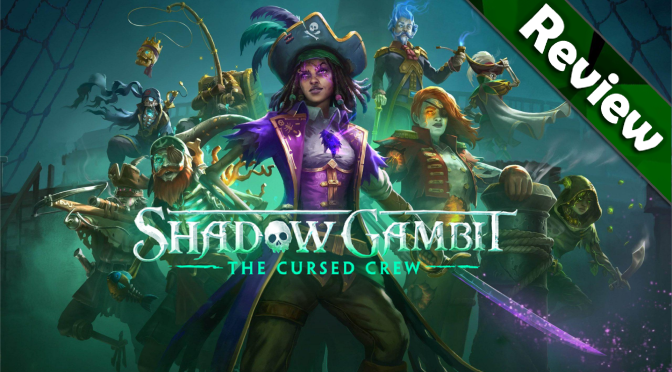Intro
Developer Mimimi Games has given us some excellent games, such as 2016’s Shadow Tactics and 2020’s Desperados III. Mimimi’s next game is finally here: Shadow Gambit: The Cursed Crew. I actually played through Desperados III and all its DLC right before playing Shadow Gambit, so it’s nice to be able to make a fresh comparison. How well does it stack up to the previous games? Let’s find out.
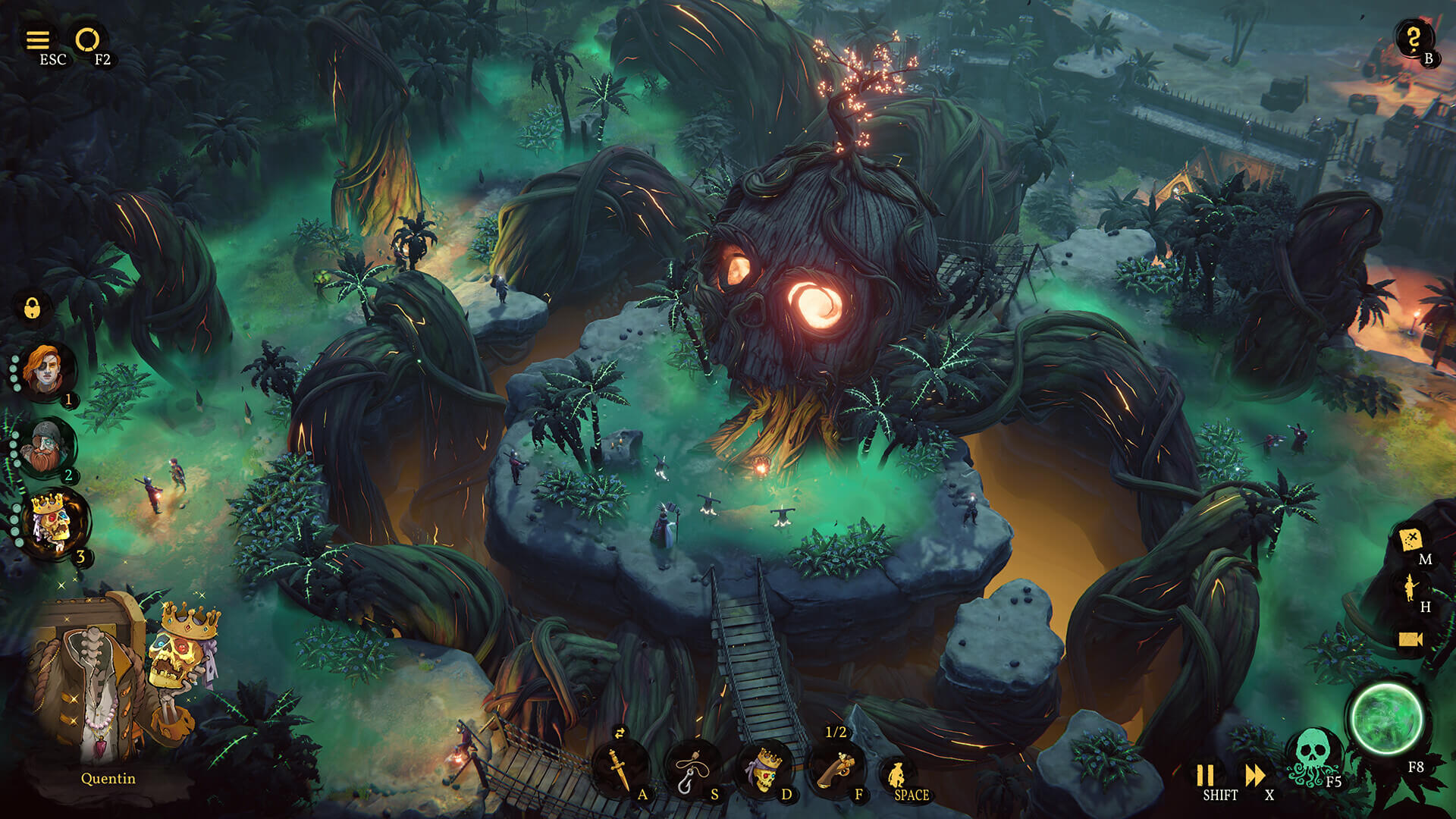
Story
The game is set in an alternate history of the Golden Age of Piracy. You play as Afia and are the navigator of a living ship named the Red Marley. This ship is in search of her captain’s treasure, and you are tasked with helping her and reviving all the old crew. The story takes place across the Lost Caribbean. Unfortunately, this mysterious island chain is under the control of the Inquisition, a group that despises anything supernatural and hunts cursed pirates like you.
I’ll keep the details vague to avoid spoilers, but all characters in this game are far more fleshed out here than in Mimimi’s previous works. Your crew all have backstories and are fully voiced, interesting, and quirky. I truly had some laugh-out-loud moments with some of the dialogue, delivered by top-notch voice professionals. In short, the story kept me invested until the end, and I immensely enjoyed it.
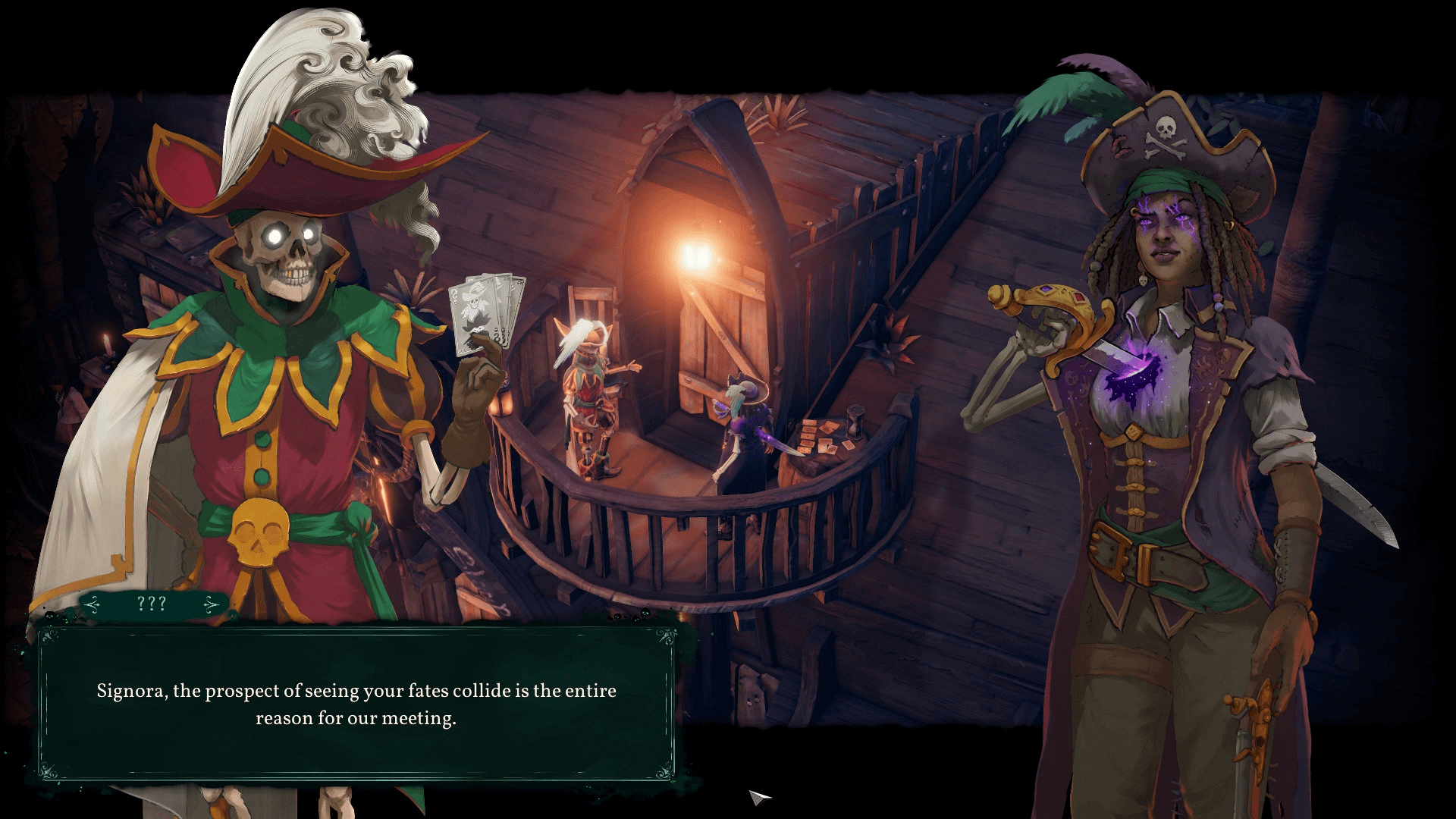
Visuals & Audio
Graphically, Shadow Gambit has a more cartoonish aesthetic than both Shadow Tactics and the more realistic Desperados III. The more surreal look perfectly suits the theme of magic and cursed buccaneers. The music is appropriate to the theme. Sound effects are significant as well, adding to the atmosphere of the game.
Gameplay
Shadow Gambit is through and through the same kind of game as Mimimi’s previous titles. For those of you who are unfamiliar, they are tactical stealth strategy games in the same vein as the old Commandos: Behind Enemy Lines series. Shadow Gambit has a few changes which I’ll get into. However, if you’ve played any of these other games you know exactly what you’ll be getting into.
To further explain, Shadow Gambit is played from a 3D isometric perspective. For most missions, you control three crew members and are tasked with completing several objectives before returning to your ship. The map is filled with various types of enemies, some stationary, others patrolling. All of them have view cones that can be seen. You need to navigate your team past them or take them out using your various abilities or the environment. If you get detected, other enemies in the area will come to your location. Reinforcements may be called in. Therefore, you ideally want to remain in stealth, but it’s not required. Each of your crew has various abilities. Depending on your playstyle and selected crew, your strategies will change. You’ll make your way through each situation, looking for openings such as environmental factors you can use to your advantage.
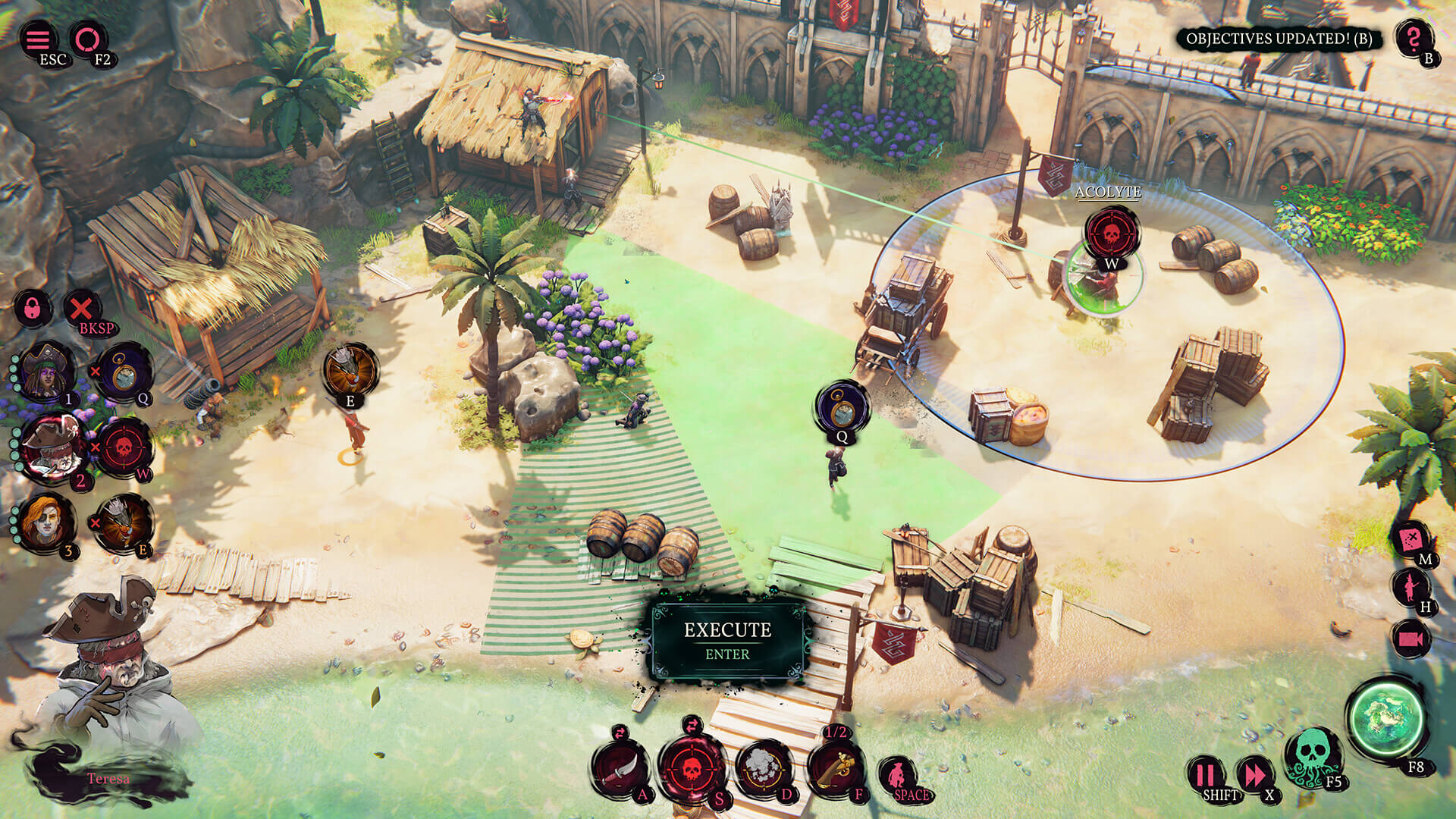
Each area provides challenges and puzzles to solve. You also can queue up commands for each team member and execute them all simultaneously to take out several guards at once. This is, in fact, required for many sections. Despite demanding careful planning, it’s very rewarding to pull off such simultaneous feats.
The nature of the game encourages frequent quicksaving to experiment with different outcomes. Such creative planning never gets old since there’s something just so satisfying about eventually pulling off the perfect maneuver. Lest you balk at quicksaving and loading, let me say that the quicksave mechanic is built into the story. As such, there is a pretty clever reason why you can go back to “earlier memories” when playing. But I’ll let you discover the reason for yourself.
Sandbox Islands
In Mimimi’s prior titles, you would simply play a stage and move on to the next until the end. In contrast, Shadow Gambit has eight islands that you will visit and revisit in your playthrough that vary in size and scope. Story missions and crew missions will have you come back to these places at other times of the day and in different locations.
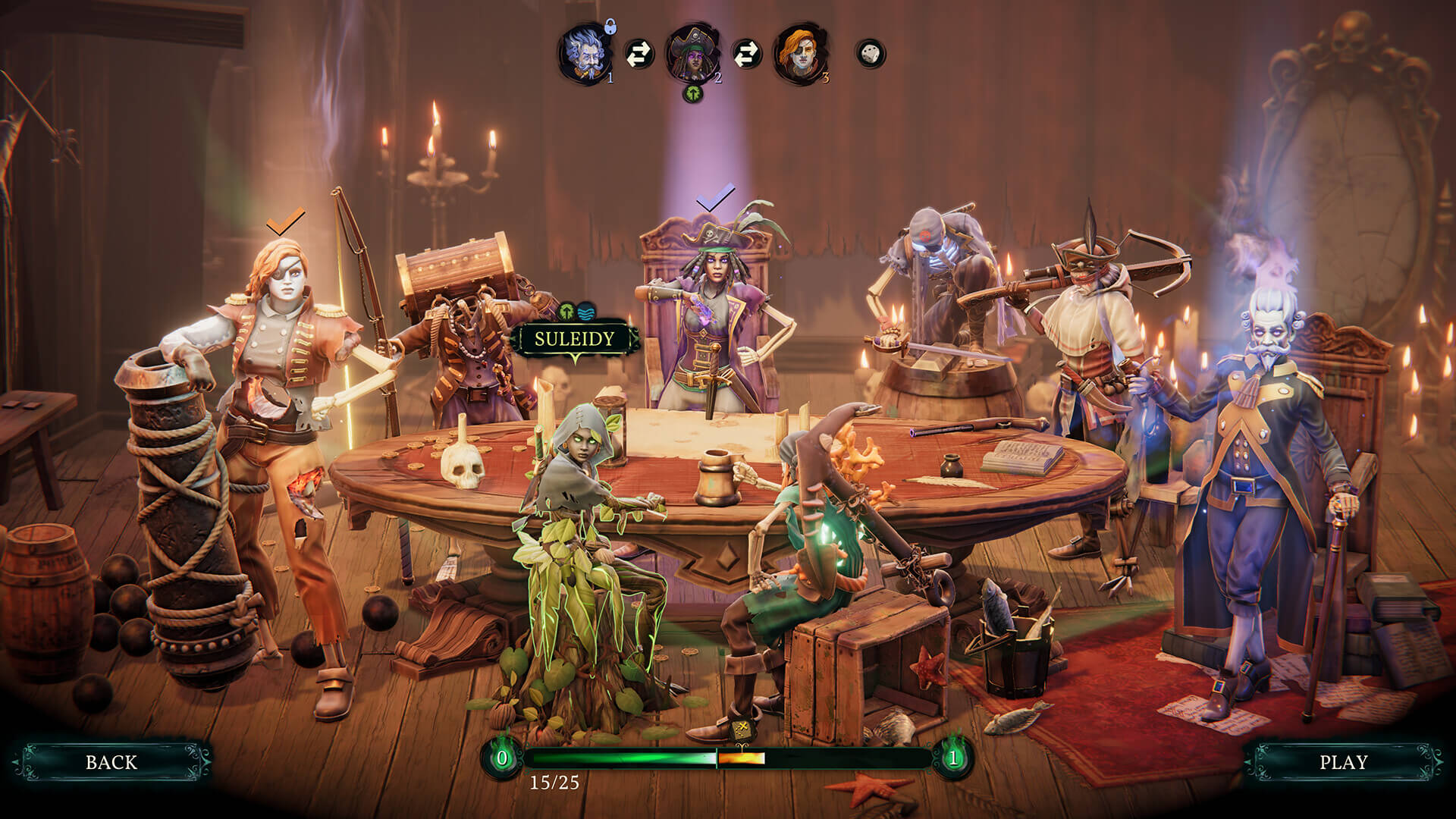
This change avoids the problem of past games taking upwards of two or more hours to clear a single stage as you systematically made your way through the entirety of the play space in one go. Shadow Gambit still retains the signature sandbox design that allows for many potential strategies and approaches on how you choose to tackle each obstacle. There are some missions here that will still take a long time since some of the islands are very large, but there is a lot more variance in the mission length in Shadow Gambit.
For example, you usually clear enemies and push through a much smaller section of each island before leaving. Later you’ll do the same concept in a different area of the island. Each mission also allows you to choose from different starting locations. You also have several options of portals through which you can extract afterward. While there are some changes regarding the locations of enemies during specific story and crew missions, the enemy locations remain mostly the same.
Thus, runs can range from quite short to quite long depending on what you need to do. And the ability to start and end at any location of your choosing adds to the variety of each go.
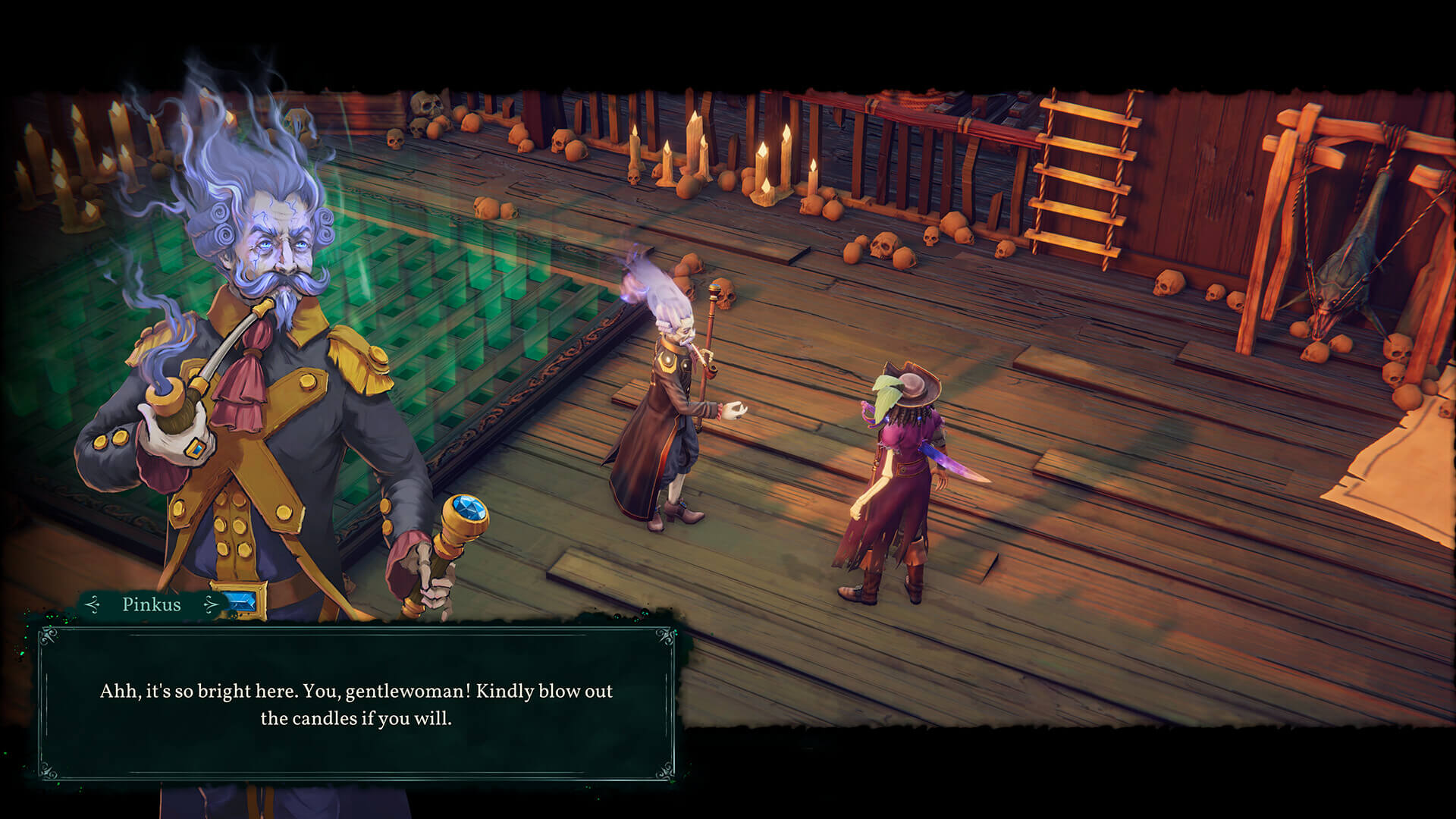
Crew Selection & Synergies
Another change is crew choice. When you start the game, you choose which crew member to revive first. Going forward, the order in which you revive the crew is also entirely up to you. All crew members are quite different from each other, so the order in which you have chosen to revive them is going to affect your team composition in the early game. Likewise, your team synergy and strategy for every mission is impacted. Desperados III would have set team members assigned depending on the story/level, and you had no choice. In Shadow Gambit, aside from specific story and crew missions, which dictate a specific crew member you are required to have on a mission, you are free to choose any unlocked crewmembers to fill your roster.
Your team makeup can drastically change the way you play as well. Suilady, the ship’s doctor can conjure a bush anywhere that blocks standing line of sight. Then your crew can use the bush to hide in, sneak behind, and cause bodies to disappear in, for example. John Mercury can burrow underground to lie in wait. He then pops up anywhere with a radius to take down an enemy and knock them to the ground.
Toya, the samurai cook, can whistle to attract enemies to his location, or place/throw his Katashiro on the ground or attach it to a guard which allows him to teleport to that location and kill the enemy. There is also a sniper, a cannoneer, and so on. The crew are all very different and work uniquely with each other. This robust interaction changes the way you approach each mission and adds a great deal of variety to each scenario.
The freedom of crew selection is enhanced by earning Vigor tokens every time you finish a mission. These accumulate until you unlock an ability upgrade for a revived crew member’s special ability. Each has upgraded abilities that can do even more to create creative combat opportunities. Another interesting aspect to this is that crew members not taken on missions accumulate one of these points for each mission they are not used on, so switching out crew between missions will net you more of these points and unlock upgrades faster.
Two new additions are crew quests and crew tales. The quests are missions for each member which take place across the various islands. Three need to be done for the campaign to move forward. Crew tales are short narrative experiences that take place on the Red Marely in between missions. They’re great and give you even more background for each crew member, which is a very nice touch. Some of them are also pretty funny (I loved Toya, the samurai chef’s tale).
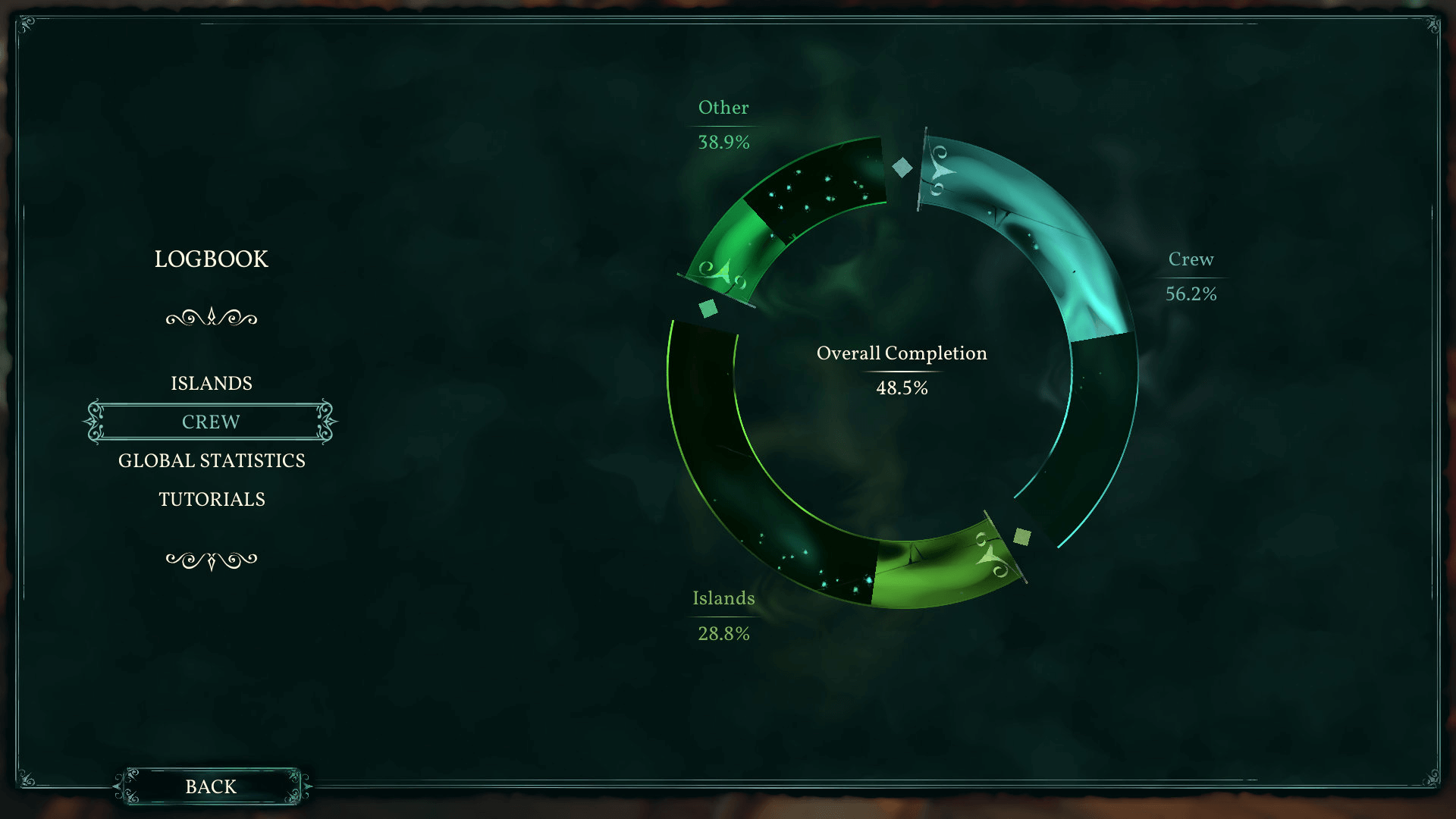
Game Length & Postgame
My playthrough took about 38 hours, and Shadow Gambit is designed to continue after completing the campaign. You can redo any of the campaign missions and try to complete challenges (badges) associated with each one. Every island has badges to earn, and each crew member has a host of badges, too. Personally, I still have a bunch of crew missions and crew tales to complete, and at least half of my ability upgrades still need to be unlocked. To put it into perspective, the game lists my overall completion at 48.5%. At 85%, you unlock a new character for your team. Therefore, there is plenty of content here for those who fall in love with the game.
Issues
The only issue I had was very specific. When putting down a view marker eye (a tool to determine which guards can see a certain location), I was unable to click it again to remove it. I had to put another one down somewhere else and then remove that one.
If I had to nitpick, occasionally my crew would move to an unexpected location. I thought I was clicking a specific location only to find that I wasn’t due to the camera angle. Similarly, if I clicked somewhere up ahead, the AI might find a shorter route that unfortunately alerted enemies. These very minor issues simply required me to be a little more careful when moving my team around.
It’s always strange to have such a short section for issues, but that was mostly it. The performance was fine. There were no audio or graphical issues. I had zero game-breaking bugs, crashes, or anything else.
Conclusion
Shadow Tactics and Desperados III were excellent games, but Shadow Gambit: The Cursed Crew has upped the bar. It takes the formula Mimimi Games has so finely honed and improves on it. You get a whimsical pirate aesthetic, fantastic island locations, a great story, and characters with interesting backstories. There is more team customization than ever before and nothing more satisfying than having your plan come together in perfect unison, after experimenting with so many diverse approaches and outcomes. Even after playing so much, there is a whole load of challenges to complete after the story concludes. It never got old for me.
If you enjoyed Mimimi’s other games, Shadow Gambit: The Cursed Crew is a must-buy as their best work yet. If you’ve never played the previous titles, strongly consider playing them because they are seriously great. Regardless, I would absolutely recommend Shadow Gambit to you as well, without hesitation.
![]()
- Excellent tactical gameplay
- Sandbox levels with plenty of approaches
- Crew tales and quests are enjoyable
- Varied team options
- Lots of replayability
![]()
- Minor pathing issues
Computer Specs:
Windows 11 64-bit computer using an Intel i7-12700k, 32GB Ram, and an nVidia RTX 3080 10gb graphics card.
Stephen is our resident kung fu master and reviewer. When he’s not kung fu fighting, he’s playing games, and has been since the atari 2600. He also runs his own YouTube channel called Particular Pixels, where he creates a variety of content related to PC gaming. He goes by the nickname Shaoling (not to be confused with Shaolin), which comes from his favorite PC game of all time, System Shock 2.

